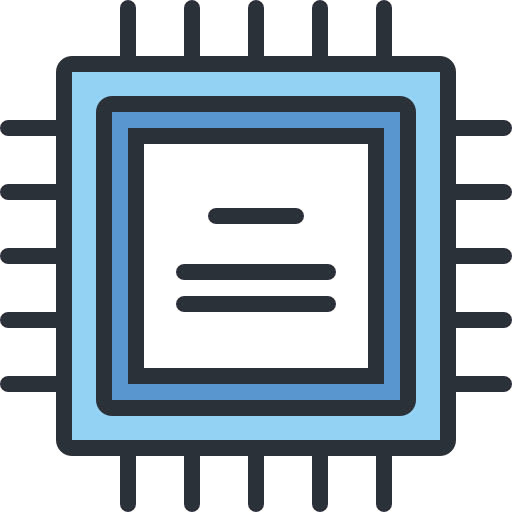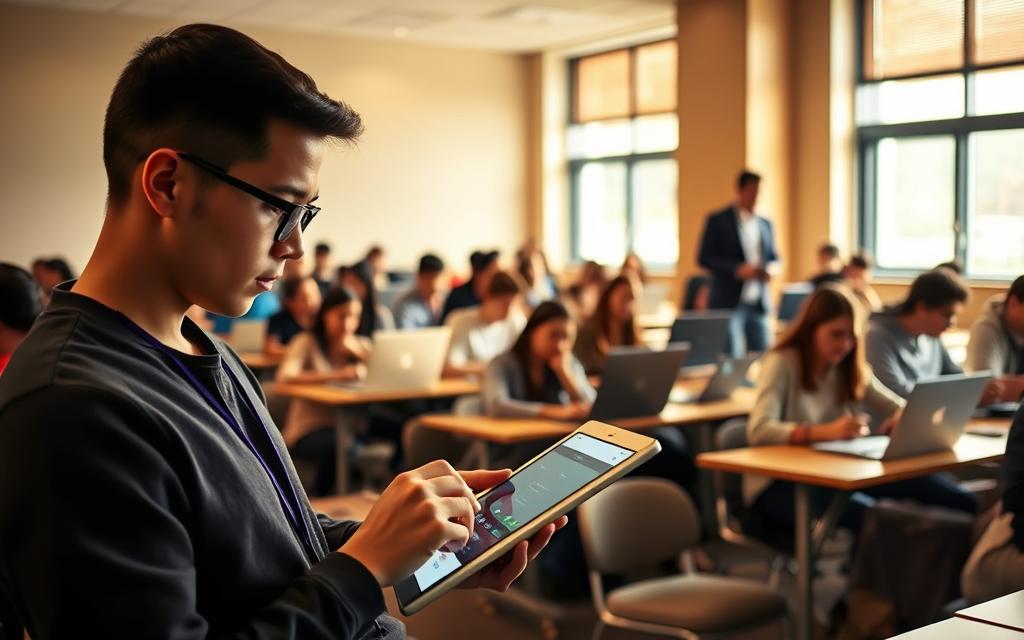Digital tools have changed education, opening up new ways to learn. They bring interactive lessons and global research to students. This gives them access to knowledge like never before.
But, there are challenges too. Students often find it hard to focus because of distractions. They get many notifications every day, making it tough to concentrate.
This educational technology guide offers tips to use tech wisely. We’ll show how to use digital tools for success. We’ll also talk about the importance of screen time and privacy.
We’ll use advice from Common Sense Media to guide you. These digital learning tips will help students succeed in their studies.
Technology can help with research, projects, and learning new skills. Let’s see how to use it to your advantage in school.
The Transformative Impact of Technology in Modern Education
Technology has changed education a lot. It started with computers in the 1980s. Now, it’s a digital world that changes how we learn and teach.
The digital transformation in schools is big. It’s not just about using new gadgets. It’s about making learning more interactive and personal for students.
Today’s classrooms use amazing tools. Interactive whiteboards and virtual reality make learning fun and real. Students can explore places and things they’ve never seen before.
Learning management systems (LMS) are key now. Tools like Google Classroom and Canvas make it easy to manage schoolwork. They help keep learning going even when you’re not in class.
The edtech benefits are huge for teamwork and getting to school. Students can work together online, no matter where they are. This is great for learning together, even when you can’t be in the same room.
| Era | Technology Focus | Primary Educational Impact |
|---|---|---|
| 1980s-1990s | Computer Labs | Basic digital literacy and word processing |
| 2000-2010 | Internet Connectivity | Information access and early online resources |
| 2011-2019 | Mobile Devices | Personalised learning and app-based education |
| 2020-Present | Integrated Platforms | Comprehensive digital learning ecosystems |
Teachers save a lot of time with new tools. They can focus more on helping students. This makes teaching better and more personal.
Students learn important digital skills. They learn to find and use online information, make digital content, and work together online. These skills help them in school and in their future careers.
Technology keeps making education better. It helps students of all abilities and languages. It also keeps learning going, even when schools can’t be open.
This change makes classrooms better for everyone. Technology is now a key part of learning. It has changed how we teach and learn in big ways.
Essential Digital Tools Every Student Should Master
Today, mastering digital tools is key to success in school. These digital tools for students make studying easier, help with teamwork, and improve grades. They are very useful when used right.

Productivity Suites: Microsoft Office and Google Workspace
Productivity software is essential for schoolwork. Microsoft Office and Google Workspace help with writing, numbers, and presentations.
They offer many benefits:
- They let you work together in real time on projects.
- They keep your files safe in the cloud, so you can access them anywhere.
- They have templates to make your work look professional.
- They keep track of changes, so you can always get back to an earlier version.
It’s important for students to learn how to use these tools well. This includes knowing how to work with spreadsheets, make good presentations, and edit together.
Research and Reference Management Systems
Good research tools are vital for school. Zotero and Mendeley make it easier to manage sources and cite them correctly.
These tools have many features:
- They automatically create citations in different styles.
- They let you highlight and annotate PDFs.
- They sync your library in the cloud, so you can access it from anywhere.
- They help you keep your research notes organised.
Using these tools well can save a lot of time. It also helps you avoid mistakes in your references.
Organisation and Note-Taking Applications
Tools like Evernote and OneNote help you stay organised. They let you manage your notes, schedule, and course materials.
Here’s how to use them well:
- Make separate notebooks for each subject.
- Use tags to find things quickly.
- Link your calendar to your tasks.
- Record lectures to listen to later.
These digital tools for students help you study better. They make it easier to keep up with different subjects.
When choosing tools, think about if they work on different devices. Also, check if they work with other productivity software you use.
Fundamental Do’s of Technology Usage for Academic Success
Using technology wisely can really boost your grades. It’s not just about using digital tools. It’s about using them in a way that helps you learn better.
Establishing Robust Digital Organisation Systems
Good digital organisation starts with a clear filing system on all your devices. Cloud services like Google Drive or Dropbox help you access files from anywhere. They also keep track of changes.
Use the same naming style for your files. Include the course code, date, and a brief description. This makes finding files much easier when you’re studying hard.
Calendars are also key for staying organised. Use different colours for different subjects or activities. Set reminders for important dates and study times.
Maximising Learning with Educational Technology
Educational tech is more than just searching online. Tools like Kahoot! and Quizlet make studying fun and help you remember things better.
Virtual reality and simulation software make complex topics easier to understand. They’re great for subjects like science and history. These tools make learning more engaging than traditional methods.
Adaptive learning platforms are the latest in tech. They adjust the difficulty of the content based on how well you do. This means you’re always learning at the right level for you.
Implementing Effective Digital Time Management
Time management for students has changed with digital tools. The Pomodoro Technique uses timer apps to help you stay focused. It breaks your study time into short, focused periods with breaks in between.
Apps like Todoist or Microsoft To Do help you keep track of your school work. They let you break down big tasks into smaller ones. This makes it easier to stay on top of your work.
Modern devices have features to help you study better. Use screen time tracking to see how you’re spending your time. Set limits on apps during study periods to avoid distractions.
It’s important to keep your school work separate from your personal life. Use specific devices or profiles for school. This helps you stay focused on your studies.
Critical Don’ts of Technology Usage for Students
Technology is great for learning, but it can also cause problems. It’s important to know what to avoid to do well in school. Knowing how to use digital tools is just as important as knowing what to avoid.
Avoiding Digital Distractions and Productivity Traps
Today’s devices can interrupt your study time a lot. Things like social media, messages, and games can make it hard to focus.
To stay focused, set clear rules for study time. Here are some tips:
- Use website blockers during study periods
- Enable “do not disturb” modes on devices
- Create separate user profiles for work and leisure
- Schedule specific break times for checking notifications

Preventing Academic Integrity Violations
Technology makes it easy to find information, but it doesn’t excuse cheating. Students must remember that they are responsible for their work.
Plagiarism detection tools are getting better. Schools use them to check for copied work.
Always give credit where it’s due. If you’re unsure, check your school’s rules or ask your teacher.
Remember, cheating can lead to serious penalties. This could mean failing a course or even being expelled.
Managing Online Presence and Digital Footprint
What you post online stays online forever. Students often don’t think about how employers or schools might see their social media.
Here are some tips for a good online image:
- Review privacy settings on all social platforms regularly
- Think carefully before posting anything
- Google yourself to check your online presence
- Remove yourself from any bad content
Your online actions should show the image you want to project. What seems okay now might look bad later.
By knowing the common technology pitfalls for students, you can make better choices online. The goal is to use technology wisely, not to avoid it.
Cybersecurity Essentials for Student Technology Users
Students now use digital platforms more than ever for their studies. It’s vital to know about cybersecurity basics. Schools offer great help, but keeping your data safe is your job.
Strong security steps keep your personal and school work safe from hackers. This part talks about key steps for students to stay safe online.
Password Management and Authentication Protocols
Good password security starts with strong, unique passwords for each account. Don’t use easy-to-guess words or personal info. Instead, choose long passphrases with words, numbers, and symbols.
Here are some tips for keeping your passwords safe:
- Use a trusted password manager for complex passwords
- Turn on multi-factor authentication when you can
- Don’t share login details via unsecured channels
- Change passwords right away if a service says there’s been a breach
Many schools now ask for multi-factor authentication to log in. This extra step makes it harder for hackers to get in, even if they guess your password.
Recognising and Avoiding Digital Threats
Staying safe online means always being on guard against new threats. Phishing emails often try to trick students by looking like they’re from the school. These emails try to rush you into acting without thinking.
Watch out for these signs of trouble:
- Requests for personal info or login details that seem sudden
- Messages with spelling mistakes or odd formatting
- Links that look almost right but are slightly off
- Attachments from people you don’t know
Malware is another big worry for students’ devices. Only get software from trusted places and keep your antivirus up to date. Also, back up your important work regularly.
University IT teams usually give tips on spotting and reporting suspicious emails. Get to know these tips and report any dodgy emails right away.
| Threat Type | Identification Signs | Prevention Measures | Response Actions |
|---|---|---|---|
| Phishing Emails | Urgent tone, generic greetings, suspicious links | Verify sender address, hover over links before clicking | Report to IT department, delete message |
| Malware Attacks | Unexpected pop-ups, slow system performance | Install reputable antivirus, avoid pirated software | Run security scan, disconnect from internet |
| Social Engineering | Requests for passwords, personal information | Never share credentials, verify request authenticity | Contact institution directly using official channels |
| Public Wi-Fi Risks | Unsecured networks, lack of encryption | Use VPN services, avoid sensitive transactions | Disconnect immediately if suspicious activity occurs |
Cybersecurity isn’t just for school. It’s also important for social media and personal emails. Always check your privacy settings and be careful with what you share online.
Learning to protect yourself online early on is key. These habits will help you stay safe in school and later in your career. The effort you put into learning these skills will keep your data safe and give you peace of mind.
Balancing Technology Use with Digital Wellness
Learning to manage digital wellness is key for students today. Technology in schools is great, but we must use it wisely. It should help us learn, not control our lives.
Too much screen time can harm our sleep, eyes, and social skills. Common Sense Media says showing good habits helps us do well in school and stay healthy.
Implementing Effective Screen Time Management
Knowing how much time you spend on screens is the first step. Many apps track your screen time, showing where it goes.
Here are some tips:
- Use apps to set screen-free times
- Turn on your device’s screen time tracking
- Set limits on fun screen time each day
- Block distracting websites when you need to focus

Plan your screen time, don’t just stop it. Pick times to check your phone, not all day.
Looking at different apps shows they help in different ways:
| Application | Key Features | Best For | Cost |
|---|---|---|---|
| Freedom | Cross-device blocking, scheduled sessions | Serious focus needs | Premium subscription |
| Forest | Gamified focus timer, tree planting rewards | Motivation challenges | Freemium model |
| Screen Time (iOS) | Built-in reporting, app limits | Apple ecosystem users | Free |
| Digital Wellbeing (Android) | Wind-down mode, focus timers | Android device users | Free |
Establishing Healthy Digital Boundaries
Setting up screen-free areas and times is important. It keeps our personal space safe from digital distractions.
Good ways to set boundaries include:
- Make bedrooms screen-free to sleep better
- Turn off devices an hour before bed
- Eat without screens to connect with others
- Have digital detox days or weekends
Tell your family and friends about your digital goals. They can support you, not get in the way.
Remember, your boundaries might change. Keep checking if they’re working for you as you grow.
Collaborative Technology for Academic Teamwork
Today, education uses digital tools for students to work together, no matter where they are. These collaborative technology solutions change how we do group projects. They make teamwork better and more efficient.
Selecting Appropriate Collaboration Platforms
Picking the right digital tools is key for good group work. Different platforms have different uses in academic teamwork tools. Google Workspace lets you edit documents together in real time. Microsoft Teams has chat and file sharing.
Learning management systems like Canvas or Blackboard have special features for school work. They have discussion boards and places to submit group work. These tools help teams work together well.

For specific tasks, tools like Trello or Asana help teams stay organised. Video calls on Zoom or Google Meet are great for virtual collaboration when you can’t meet in person.
Best Practices for Virtual Teamwork Efficiency
Good virtual collaboration needs the right tools and smart strategies. Regular updates keep everyone in the loop. This keeps the team working together smoothly.
It’s important to know who does what to avoid confusion. Using version control in documents keeps everything clear. This way, teams can see who changed what.
Shared calendars help everyone stay on the same page. Quick messages or video calls keep projects moving. This keeps everyone informed and on track.
Writing down decisions and tasks in shared notes keeps everyone on the same page. This turns collaborative technology into a powerful tool for success.
Adapting Technology to Individual Learning Styles
Educational technology is very flexible and can meet different learning needs. Knowing your learning style helps you pick the right digital tools. This makes technology a personal learning partner, not just a tool.

Technology Solutions for Visual Learners
Visual learners do well with graphics and images. Tools like Canva turn complex data into easy-to-understand visuals. YouTube Edu offers videos that show concepts through animation.
Mind mapping software is also great for visual learner tools. Apps like MindMeister let students arrange ideas in a map. This helps them see connections and remember better.
Digital Support for Auditory and Kinesthetic Learners
Auditory learning apps help those who learn best through sound. Tools that read text aloud and podcasts are perfect. Recording lectures helps them review later.
Kinesthetic learners need to touch and do things. Interactive simulations and virtual labs offer hands-on learning. Coding platforms like Scratch give instant feedback, making it fun.
Educational games are also great for kinesthetic learners. They make learning active and fun. The games give feedback right away, keeping learners engaged.
Using learning styles technology in a personal way makes learning better. The right tools make hard ideas easy to grasp. This way, everyone can learn and remember more.
Emergency Preparedness for Technology Reliance
Technology is key to your studies. But, unexpected problems can stop you. Having strong emergency plans keeps your studies on track, even with tech issues.
Comprehensive Data Backup Strategies
Protecting your work is vital. Here are key steps to keep your data safe:
- Cloud storage solutions: Google Drive or Microsoft OneDrive syncs your files everywhere
- External hardware backups: Regularly save to external hard drives for extra safety
- Automated scheduling: Set up weekly backups to keep your data safe
- Version history utilisation: Many platforms let you recover deleted or edited files
University IT teams say the 3-2-1 rule is key. Keep three copies of your data, on two different types of media, and one off-site.
Technical Issue Resolution Protocols
When tech problems arise, knowing how to fix them quickly is important. Here’s a step-by-step guide:
- Write down the problem and any error messages
- Check your university’s IT support website for answers
- Use your computer’s built-in tools to diagnose issues
- Reach out to IT support with all the details
- Find ways to keep studying while waiting for help
Many schools offer remote IT help. This lets techs fix your problems without visiting. Keep IT support’s contact info handy, in both digital and physical forms.
Talking openly with teachers about tech problems helps too. This way, you can get the help you need while studying. This plan makes dealing with tech issues easier.
Conclusion
This summary shows how to use technology to improve your school work. It’s key to stay organised, keep your data safe, and look after your well-being. These steps are vital for your school journey.
Learning to use tools like Microsoft Office and Google Workspace is important. It’s also vital to stay away from distractions and keep your online world safe. By doing this, you use technology wisely and stay true to your academic values.
Use these tips to find a good balance with technology. Always keep learning and adapting. This will help you become more skilled with technology and reach your goals.







